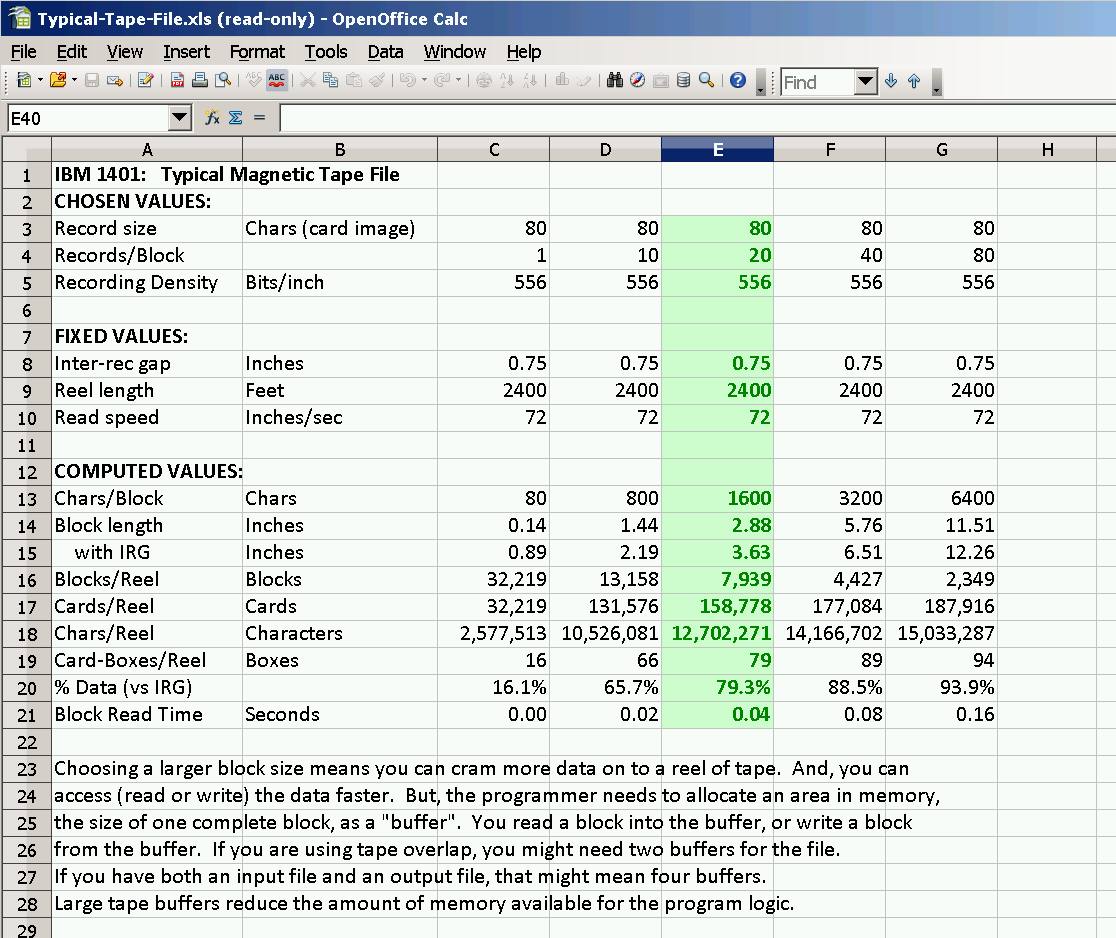Magnetic Tape Capacity
and the Effect of "Tape Blocking"
- not of general interest to restoration ;-))
Background:
There is a 3/4 inch gap ("Inter-Record Gap") between Physical Tape Records on tapes
of 200, 556 and 800 characters/inch tape format where no data is written.
(The above describes the Model 729 tape drives on the restored the 1401s.)
- No user data is placed in this gap. (There is a check character which is written after the
last data character - two character positions of no magnetic transitions then
the check character is written.)
It is usually considered a good thing to put as many data records into one physical
tape record as practical.
This permits more data per tape, and allows more data records to be written or read per second.
Factors of physical memory available, statistics of tape defects per length of tape,
and other factors, tend to limit the desirable size of physical tape records.
Background info on tape write error recovery:
A standard software recovery (simplified) from a detected tape write error is to
- assume a small tape defect
- back up over the defective tape block just written
- write an end of file mark (three inches blank tape followed by a special character)
- back up over the special character
- re-write the tape block after the three inch blank area
(containing the bad spot)
Because computers are so fast relative to physical I/O, the computer time to block and unblock physical records (as in sorting) is considered rather inconsequential.
|
Capacity of 2400 foot reel using 80 character records at 556 bits/inch
and various tape blocking ( various 80 character records in one data block )
From Stan Paddock, Sept 2013 |

|
The Effect of "Tape Blocking"
- from Stan Paddock, Sept 28, 2013, was in .xls format
| Basis | Tape length | 2,295 | feet of tape used for data |
| Tape density | 556 | Bits Per Inch (6 bits wide) | |
| Data record length | 80 | One 80 column card | |
| Blocking Factor | 1 to 20 | Cards per data block | |
| Maximum data | 12,145,600 | Maximum data |
| Blocking factor | Record length + IRG (inches) | Data Length (inches) | Percent data | Number of data blocks | Characters on tape | Cards on tape |
| 1 | 0.894 | 0.144 | 16.1% | 30,809 | 2,464,720 | 30,809 |
| 2 | 1.038 | 0.288 | 27.7% | 26,537 | 4,245,920 | 53,074 |
| 3 | 1.182 | 0.432 | 36.5% | 23,306 | 5,593,440 | 69,918 |
| 4 | 1.326 | 0.576 | 43.4% | 20,776 | 6,648,320 | 83,104 |
| 5 | 1.469 | 0.719 | 49.0% | 18,742 | 7,496,800 | 93,710 |
| 6 | 1.613 | 0.863 | 53.5% | 17,070 | 8,193,600 | 102,420 |
| 7 | 1.757 | 1.007 | 57.3% | 15,672 | 8,776,320 | 109,704 |
| 8 | 1.901 | 1.151 | 60.5% | 14,486 | 9,271,040 | 115,888 |
| 9 | 2.045 | 1.295 | 63.3% | 13,467 | 9,696,240 | 121,203 |
| 10 | 2.189 | 1.439 | 65.7% | 12,581 | 10,064,800 | 125,810 |
| 11 | 2.333 | 1.583 | 67.8% | 11,805 | 10,388,400 | 129,855 |
| 12 | 2.477 | 1.727 | 69.7% | 11,120 | 10,675,200 | 133,440 |
| 13 | 2.621 | 1.871 | 71.4% | 10,509 | 10,929,360 | 136,617 |
| 14 | 2.764 | 2.014 | 72.9% | 9,962 | 11,157,440 | 139,468 |
| 15 | 2.908 | 2.158 | 74.2% | 9,469 | 11,362,800 | 142,035 |
| 16 | 3.052 | 2.302 | 75.4% | 9,023 | 11,549,440 | 144,368 |
| 17 | 3.196 | 2.446 | 76.5% | 8,616 | 11,717,760 | 146,472 |
| 18 | 3.340 | 2.590 | 77.5% | 8,245 | 11,872,800 | 148,410 |
| 19 | 3.489 | 2.734 | 78.5% | 7,905 | 12,015,600 | 150,195 |
| 20 | 3.628 | 2.878 | 79.3% | 7,591 | 12,145,600 | 151,820 |
There was a flury of e-mails in 2009, including :
|
From: Stan Paddock Subject: Re: Question: How many equiv punched cards did a 2400-ft reel hold? Date: October 15, 2009 7:48:40 PM PDT To: ... Bill, Last Wednesday I ran a short program to try and figure this out.
7,591 records 151,820 80 character cards 12,145,600 characters 2,295 feet of tape used for data Extrapolating to 800 BPI 10,014 records 200,280 cards 16,022,400 characters 2,295 feet of tape used for data According to Ron Williams, most customers used 556 BPI because 800 BPI was not that reliable on the 1401. Stan |
|
From: Bob Feretich Subject: Re: Question: How many equiv punched cards did a 2400-ft reel hold? Date: October 13, 2009 8:01:18 PM PDT To: ... The 729-V drive didn't ship until later. The 729-II drive was available with the 1401. The 729-II maximum density was 556 CPI. Do some good record blocking, but still having inter-record gaps... and 441 CPI average sounds like a reasonable number. Regards, Bob |
updated Sept 26, 2013
